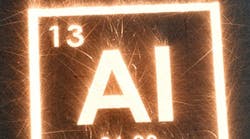Nanoparticles Expand the Horizon for 3D Printing High-Strength Alloys
Researchers from HRL Laboratories reveal a method of 3D printing that could lead to more reliable welding techniques for aerospace-grade alloys, and high-strength custom designs enabled by 3D printing. The methods reduce adverse effects like hot cracking and the formation of irregular lattice structures. They are published in the September issue of the journal Nature.
The team used software from Citrine Informatics to identify candidate nanoparticles for optimized nucleation--or lattice formation--in the alloy during solidification. Nucleation is an energy-driven process that creates bonds within materials undergoing phase changes. By adding impurities that position themselves at the alloy's nucleation sites, the scientists could speed up the rate of nucleation as they applied heat with a laser. The ability to apply heat for less time at an exact laser wavelength reduced the chances of hot cracking, which can make the final solid metal flaky like a croissant (yum). Generally speaking, the nanoparticles used for experimentation were chosen based on their potential to form controlled lattice structures.
After testing with several candidates, the team finally settled on using zirconium-based nanoparticles at the nucleation sites. They used a laser to melt thin layers of alloy powders into liquid, and then initiate nucleation between layers to produce a final a solid product. Their method of adding nanoparticles to enable rapid laser heating is called nanofunctionalization.
The team designed their method around using aluminum alloys Al7075 and Al6061, which are common alloys used in aerospace and automotive applications. While 3D printing high-strength alloys has typically been limited to alloys like AlSi10Mg, TiAl6V4, CoCr, and Inconel 718, the new research could be used to replace current nucleation techniques for a wide range of steel alloys and nickel-based superalloys. And while current nucleation techniques for high-strength alloys tends to generate elongated or irregular fibers in the resulting solid, the new method creates metal grains that are almost spherical, making it more favorable for multi-directional loading.
